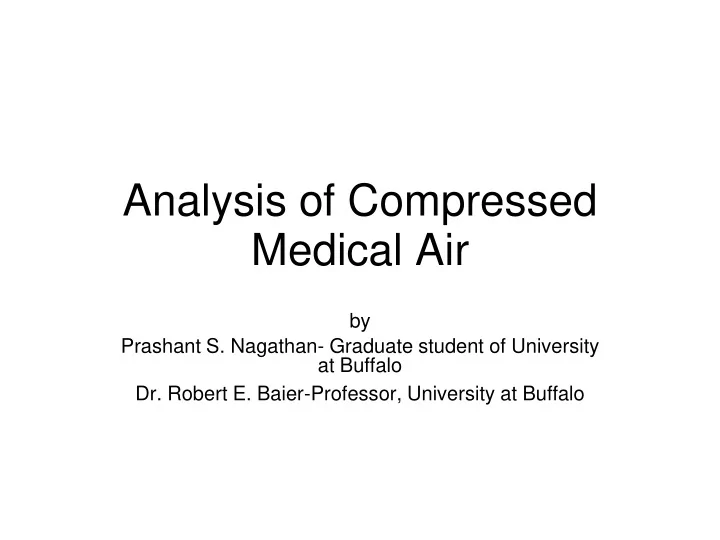

Analysis of Compressed Medical Air by Prashant S. Nagathan- Graduate student of University at Buffalo Dr. Robert E. Baier-Professor, University at Buffalo
Introduction • Medical air produced on site • Medical air is used for patients-neonates, patients suffering from respiratory disease • Medical air is governed by NFPA under USP • No specification on microbial contamination limits
Materials and Methods • Medical air samples were taken at 5 hospitals and at dental school • SMA sampler and Modified Andersen sampler used for analysis of microbial contamination in medical air • Both samplers were operated for 3 minutes and 1 minute @ 1CFM • In hospital-1 the medical air was also sampled for 35 minutes using both samplers @ 1CFM
Modified Andersen sampler & SMA sampler operating in hospital-1
Modified Andersen sampler Pressure gauge Pressure regulator Stainless steel inlet Stainless steel hose Air flow meter Andersen Sampler
Materials and Methods (contd.) • Four media-BA, R2A, TSA, RBA were used to detect human associated, environmental associated, thermophilic bacteria and fungi, respectively • BA was kept at 35 o C for 4 days • R2A was kept at 23+/-3 o C for 4 days • RBA was kept at 23+/-3 o C for 7 days • TSA was kept at 56 o C for 4 days
Check for Microbial growth on the four media SMA sampler Modified Andersen sampler
Air impactor
Materials and Methods (contd.) • Germanium prism placed in Air impactor • Medical air was bombarded on germanium prism kept in the Air impactor for 1 hour • Germanium prism held in front of connector by attachments • Medical air deposits on prism were analyzed for organic matter and particulate debris by Infrared spectroscopy, SEM and EDX
Prism kept in the prism holder held in front of connector Prism holder Germanium prism Connector
Typical IR spectra-medical air Hospital-1 Hospital-2 Hospital-3 Hospital-4
Results • Twenty four (24) media of each type were used for medical air sampling at each hospital • No microorganisms were detected on the media from 5 hospitals • From the IR spectroscopy analysis no chemical bands were detected except for hydrocarbons in hospital-5
IR spectrum-medical air Hospital-5
Results (contd.) • SEM showed particles were in size range 0.1 micrometer to 100 micrometer • EDX analysis showed particles contained these elements: Cu, Sn, Ca, Cl, K, Fe, Li, Zn, Al, Mg, Br, Si
SEM and EDX of particle agglomerate on prism Sn, Cu, Zn, Li elements detected from the agglomerate of particles by EDX shown in the figure
SEM and EDX of the particle from the medical air bombarded on prism KBr detected by the EDX shown in the figure.
SEM and EDX of the particle from the medical air bombarded on prism KCl salt particle detected by EDX
SEM and EDX of the particle from the medical air bombarded on prism Li, Zn, Cu, Ca, Sn, Cl elements are detected by EDX
SEM and EDX of the particle from the medical air bombarded on prism Size of the particle is approximately 100 micrometers
Analysis of Compressed air from the dental school • Centralized compressor supplies the compressed air for the labs and dental clinic • Compressor is oil-free and refrigerant based drying • SMA, Modified Andersen sampler used for analysis of air for detection of microorganisms • Both samplers were operated for 35 minutes @ 1CFM
Analysis of Compressed air from the dental school (contd.) SMA sampler operating Modified Andersen sampler in the lab operating in the lab
Analysis of Compressed air from the dental school (contd.) Compressed air samples from air tap using SMA, Modified Andersen sampler, SMA on top of Andersen sampler, 1CFM, 35 min
Analysis of Compressed air from the dental school (contd.) Control Compressed air samples from dental chair using Modified Andersen sampler, 1CFM, 35 min
Analysis of Compressed air from the dental school (contd.) Prism holder Germanium prism Air tap
Analysis of Compressed air from the dental school (contd.) • Germanium prism placed in the prism holder was kept in front of the air tap • The compressed air was bombarded on the prism for 1 hour • Compressed air deposits on prism were analysed for organic matter and particulate debris by Infrared spectroscopy, SEM and EDX
Analysis of Compressed air from the dental school (contd.) IR spectrum from the IR spectrum from the compressed air deposits-lab compressed air deposits-lab B30 308
Analysis of Compressed air from the dental school (contd.) Elements-Al, Sn, S detected by EDX
Analysis of Compressed air from the dental school (contd.) Elements- Cu, Zn, Cl, S detected by EDX
Discussion • Dr. Bjerring and Dr. Oberg had detected bacterial contamination in medical air in one hospital of Denmark • No detectable microorganisms in medical air, confirming effectiveness of use of oil- free compressors and refrigerant based drying • Collected previously uncharacterized metallic and flux particles from medical air systems at all five test sites
Discussion (contd.) • Particles detected could derive from fluxes during the welding operations of piping joints • The efficiencies of the two sampler could not be compared because no microorganisms detected in medical air in any case
Future work • Cross check Modified Andersen and SMA sampler in controlled air volumes seeded with known microorganisms • Detection of Legionella bacteria in medical facilities • Concentration of particles in the medical air • Detection of SO 2 , NO and NO 2 during peak hours of traffic
Acknowledgement I sincerely thank • Praxair Inc. • Dr. Robert E. Baier • Plant operation managers of the Hospitals
Recommend
More recommend